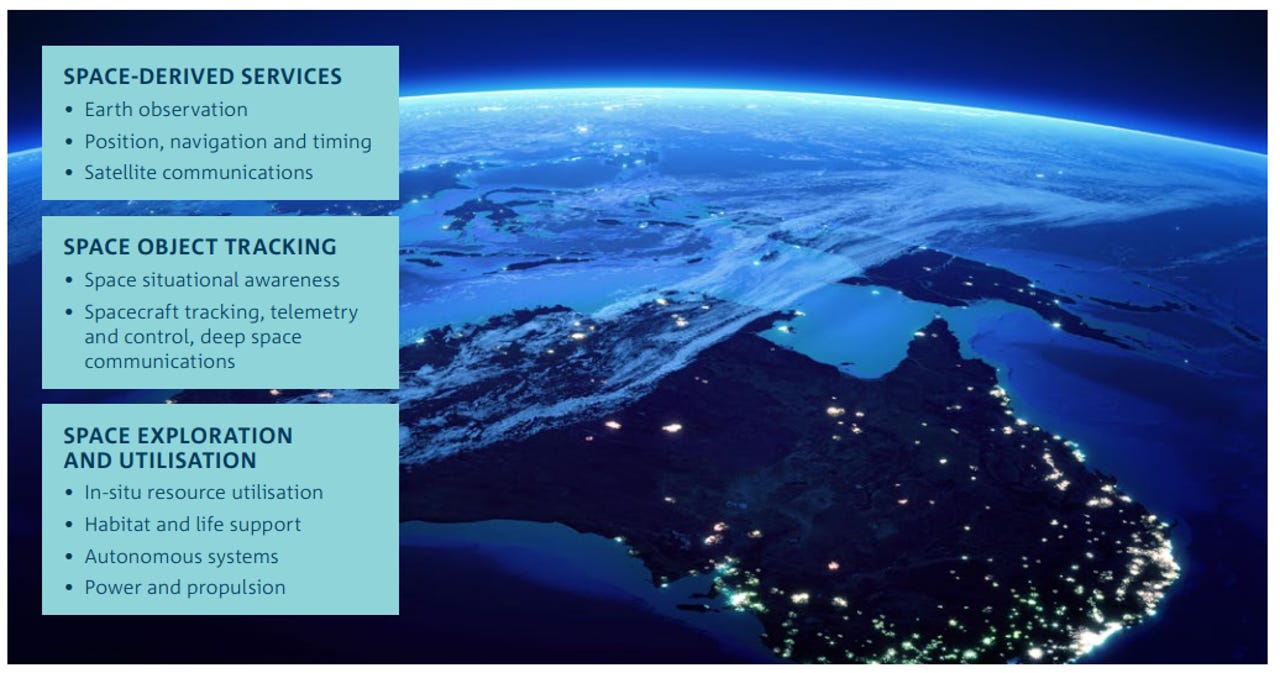CSIRO directs space agency away from humans and towards commercialisation


Australia's key opportunities for growth
Australia has had an official space agency for three months now, after the federal government announced during the 2018-19 Budget that it would be committing AU$41 million to the creation of the Australian Space Agency and AU$260 million to further develop satellite capabilities.
Under the guidance of former Commonwealth Scientific and Industrial Research Organisation (CSIRO) boss Megan Clark, the agency has a mandate to triple the size of Australia's domestic space industry up to AU$12 billion by 2030, generating 20,000 new Australian jobs, and getting more kids to take up STEM-focused careers.
According to CSIRO, Australia's space industry is estimated to have generated revenues of AU$3-4 billion last year, with a workforce of around 10,000.
In order to boost that revenue, CSIRO Futures, which is the strategy advisory arm and a partner of Australia's national science agency, has produced a new roadmap helping to determine the direction the country's space industry should take, highlighting that it isn't just about putting people on the moon, rather the commercialisation of all things space.
Launched on Monday, Space: A Roadmap for unlocking future growth opportunities for Australia 2018 [PDF], focuses on three main areas for potential development: Space-derived services, space object tracking, and space exploration and utilisation.
Using space data and satellite communications to grow "downstream" commercial applications, CSIRO expects that for example, the use of Earth observation data can be used for a range of services such as remote asset management, and environmental monitoring and assessment.
"Satellite imagery and accurate positioning services are enabling the development of precision agriculture methods, with reports estimating that the value of Australian satellite imagery-enabled precision farming for broad acre cropping could reach AU$221 million annually by 2025, up from AU$17 million in 2015," CSIRO wrote of Australia's opportunity in space-derived services.
"Space-derived services and related technologies also improve the Australian way of life through the provision of more accurate satellite navigation, satellite TV services, internet access enabling telemedicine services for rural communities, nation-wide weather forecasts, and disaster monitoring."
Where space object tracking is concerned, CSIRO's report places heavy emphasis on the country's geographical location.
"A key advantage driving Australia's space industry is the nation's strategic southern hemisphere location and land mass -- characteristics that provide a 'sweet spot' for space-related activities and allow for low light and electromagnetic interference," the report says.
"These attributes make Australia an attractive partner for integration into global value chains and provide advantages for development of positioning services and technology, Earth observation calibration, validation and data analytics, and space situational awareness activities."
The market for this opportunity includes Defence and relevant civil authorities, as well as the specific focus on tracking space debris.
Space exploration and utilisation -- defined by CSIRO as building on Australia's strengths across different industries to apply new technologies and systems to the challenges of robotic and human space exploration -- will see the space agency focus on developing "niche technologies for global value chains".
Specific examples offered by CSIRO include using the country's strengths in mineral resources and advanced manufacturing to develop in-situ resource utilisation technologies; strengths in food, agriculture, medicine, and remote asset management to develop habitat and life support systems; strengths in energy systems to improve power and propulsion; and strengths in robotics and sensors to develop autonomous systems.
"We really want to make sure that we can transform Australia's space industry, triple the size of it in the short term, but importantly across the whole economy, we want to increase the use of space to really drive all of our sectors, whether it's agriculture, banking, etc, so that Australia really takes its place in what is an industry that is just transforming what is what we do on Earth," Clark told ABC RN Breakfast on Monday morning.
"As an island where over 70 percent of our land mass, we still can't make telephone call, things like communication and making sure we're at the next-generation of communications are vital -- and Australia is a fantastic place to connect from Earth to space."
Although the Australian Space Agency begun operation on July 1, 2018, it is yet to have a place to call home.
The boasting rights to the agency will be determined during a six-month bidding war between states and territories, with a decision expected by the end of the year.
"We visited all the states and territories and had discussions with all the premiers and first ministers a couple of times over this, and what is been a real surprise is just how much is going on in every state and territory," Clark said in response to a question asking where the agency will be located.
RELATED COVERAGE
- Australian states and territories to battle for space agency boasting rights
- Australian space capabilities would boost our Five Eyes role: Former astronaut
- Australia partners with France for space program development
- South Australian Budget earmarks millions for innovation and startups
- Australia to fire its pork barrel into space
- Former CSIRO boss Dr Megan Clark to lead the Australian Space Agency
- Defence backs Saber Astronautics with AU$1.2m contract for space security
- The Australian government is funding its very own space agency (CNET)
- AI in space: Astronauts will get floating robot assistant thanks to IBM, Airbus (TechRepublic)